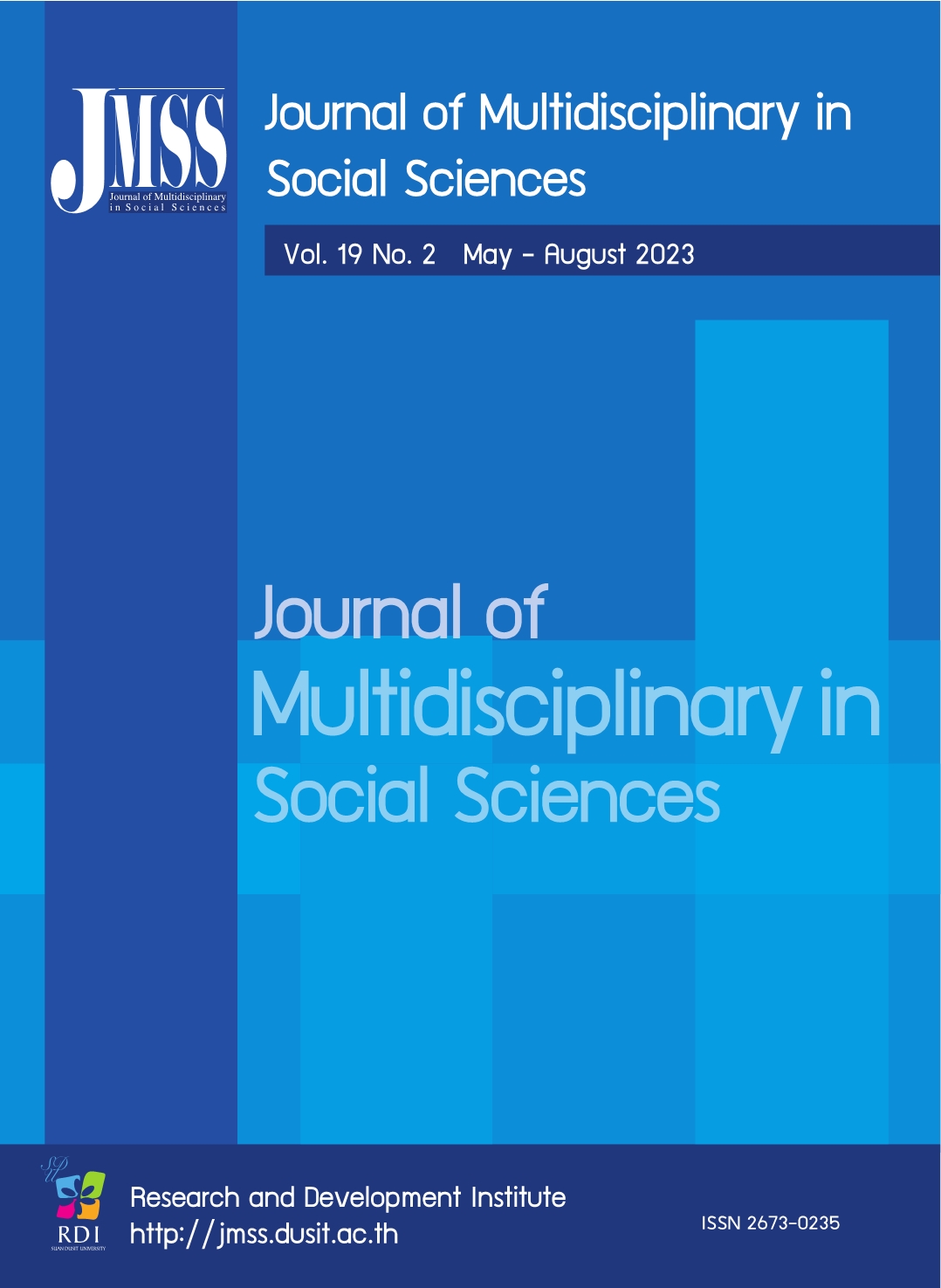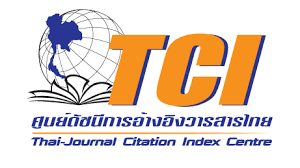A Review of Lexico-grammatical Features and their Functions in an Academic Discourse
Keywords:
Lexico-grammatical feature, Communicative function, Academic paper, Research paperAbstract
Successful academic and research writings require correct comprehension of lexical and grammatical uses as a method to understandthe meanings as well as the specific functions in the texts. Woravit Kitjaroenpaiboon and Kanyarat Getkham stated that academic and research writings are not a skill naturally acquired, but needs to be learnt and practiced.. Furthermore, plentiful scholars have proven that some lexical features and grammatical features are found predominantly in the classification not in ordinary language. The lexico-grammatical in this category do not adhere to and are somewhat different from what have been explained in the traditional grammar book. The above statements prove that if one wants to draft an effectively communicative academic or research papers, we should understand how lexico- grammatical function in the particular texts. This paper hence reviews both of related literatures and research studies particularly viewed 23 lexico-grammatical characteristics (i.e. tenses and aspects, passive voice, private, public and suasive verbs, pronouns, downtoners and hedges, possibility, necessity, and prediction modals, synthetic and analytic negations, ‘be’ as main verbs, emphatics, causative subordinations, ‘that’ compliment clauses, wh-clauses, ‘that’ deletion, coordinating conjunctions, sentence relatives, nouns, average word length, type/token ration, predicative and attributive adjectives, adverbs, split auxiliaries, infinitives, gerunds, and participial clauses) in academic and research writings. This review article can benefit researchers who are conducting academic or research papers or others intrigued in investigating specifically underlying communicative functions of a lexico- grammatical feature(s).
References
Alvin, L. P. (2014). The passive voice in scientific writing: The current norm in science journals. Science Communication, 13(1), 1-16.
Amdur, R., Kirwan, J., & Morris, C. G. (2010). Use of the passive voice in medical journal articles, American Medical Writers Association Journal, 25(3), 98-110.
Auria, M. P. (2008). Stance and Academic Promotionalism: A cross-disciplinary comparison in the soft sciences. Journal of the Spanish Association of Anglo-American studies, 30(1), 129-145.
Ayers, G. (2008). The evolutionary nature of genre: An investigation of the short texts accompanying research articles in the scientific journal Nature. English for Specific Purposes, 27(1), 22-41.
Baoya, Z. (2015). Moves and inter-move linguistic variation in education research articles (Unpublished doctoral dissertation). Suranaree University of Technology. Nakornrachaseema, Thailand.
Barber, C. L. (1962). Some measurable characteristics of modern scientific prose in contributions to english syntax and phonology. Gothenburg Studies in Linguistics, 14(3), 1-14.
Bazerman, C. (1984). The writing of scientific non-fiction. Pre Text, 5(1), 39-74.
Bazerman, C. (1988). Modern evolution of the experimental report in physics: Spectroscopic articles in physical review 1893-1980. Social Studies of Science, 14(1), 163-196.
Biber, D., & Conrad, S. (2009). Register, genre, and style. Cambridge: Cambridge University Press.
Biber, D., & Finegan, E. (1994). Intra-textual variation within medical research articles. Amsterdam: Rodopi.
Biber, D., & Gray, B. (2010). Challenging stereotypes about academic writing: complexity, elaboration, and explicitness. Journal of English for Academic Purposes, 9(1), 2-20.
Biber, D. (1995). Variation across speech and writing. Cambridge: Cambridge University Press.
Biber, D., Conrad, S., & Reppen, R. (1998). Corpus linguistics: Investigating language structure and use. Cambridge: Cambridge University Press.
Biber, D., Johansson, S., Leech, G., Conrad, S., & Finegan, E. (1999). Longman grammar of spoken and written English. London: Longman.
Burrough-Boenisch, J. (2003). Shapers of published NNS research articles. Journal of Second Language Writing, 12(3), 223-243.
Celce-Murcia, M., & Larsen-Freeman, D. (1999). The grammar book. Boston: Heinle & Heinle.
Charak, A., & Norouzi, Z. (2013). Rhetorical moves and verb tense in abstracts: A comparative analysis of American and Iranian academic writing. International Journal of Language Studies, 7(4), 101-110.
Charles, M. (2006a). Phraseological patterns in reporting clauses used in citation: A corpus-based study of theses in two disciplines. English for Specific Purposes, 25(3), 310-331.
Charles, M. (2006b). The construction of stance in reporting clauses: A cross-disciplinary study of theses. Applied Linguistics, 27(3), 492-518.
Corson, T., & Smollett, R. (2013). Passive voice: When to use it and when to avoid it. Toronto: University of Toronto.
Corson, T., & Smollett, R. (2014). Writing at the university of Toronto. Retrieved January 20, 2022 from http://www.writing.utoronto.ca/advice/style-and-editing/passive-voice
Crismore, A., & Vande Kopple, W.J. (1997). Hedges and readers: Effects on attitudes and learning. Berlin: Walter de Gruyter.
Eastwood, J. (1999). Oxford practice grammar. Oxford: Oxford University Press.
Flottum, K., Dahl, T., & Kinn, T. (2006). Academic voices: Across languages and disciplines. Philadelphia: John Benjamins.
Gerbert, M. (1970). Besonderheiten der syntax in der technischen fachsprashe des englischen. Halle: Niemeyer.
Getkham, K. (2010). A corpus-based study of applied linguistic research articles: A multidimensional analysis. National Institute of Development Administration.
Glasman-Deal, H. (2010). Science research writing: for nonnative speakers of English. London: World Scientific.
Gledhill, C. (2000). The discourse function of collocation in research article introductions. English for Specific Purposes, 19(2), 115-135.
Grabe, W., & Kaplan, R.B. (1997). Theory and practice of writing: An applied linguistic perspective. London: Longman.
Grieve, J. Biber, D., Friginal, E., & Nekrasova, T. (2008). Variation among blogs: A multidimensional analysis. New York: Springer-Verlag.
Gross, A. G., Harmon, J. E., & Reidy, M. (2002). Communicating science: The scientific article from the 17th century to the present. Oxford: Oxford University Press.
Gunawardena, C. N. (1989). The present perfect in the rhetorical divisions of biology and biochemistry journal articles. English for Specific Purposes Journal, 8(2), 265-273.
Halliday, M. A. K. (1998). Introduction to functional grammar. London: Arnold.
Halliday, M. A. K., & Hasan, R. (1996). Cohesion in English. London: Longman.
Halliday, M.A. K., & James, Z. L. (1993). A quantitative study of polarity and primary tense in the English finite clause. London: Routledge.
Halliday, M. A. K. (2013). Halliday’s introduction to functional grammar. London: Routledge.
Hanania, E., & Akhtar, K. (1985). Verb form and rhetorical function in science writing: A study of MS theses in biology, chemistry and physics. English for Specific Purpose Journal, 4(1), 49-58.
Hartwell, L. M., & Jacques, M. (2014). Authorial presence in French and English: “Pronoun + verb” patterns in biology and medicine research articles. Discourse, 15(1), 213-245.
Hawes, T. & Thomas, S. (1997). Tense choices in citations. Research in the Teaching of English, 31(1), 394-414.
Heslot, J. (1982). Tense and other indexical markers in the typology of scientific texts in English. Copenhagen: Copenhagen School for Economics.
Hewings, M., & Hewings, A. (2002). It is interesting to note that: A comparative study of anticipatory ‘it’ in student and published writing. English for Specific Purposes, 21(4), 367-383.
Hiltunen, T. (2010). Grammar and disciplinary culture: A corpus-based study. Helsinki: University of Helsinki.
Hunston, S. & Sinclair, J. (2000). A local grammar of evaluation. Oxford: Oxford University Press.
Hunston, S., & Thompson, G. (2001). Evaluation in text: Authorial stance and the construction of discourse. Oxford: OUP.
Hyland, K. (1994). Hedging in academic writing and EAP textbooks. English for Specific Purposes, 13(3), 239-256.
Hyland, K. (1998). Hedging in scientific research articles. Amsterdam: John Benjamins.
Hyland, K. (2001). Humble servants of the discipline: Selfmention in research articles. English for Specific Purposes, 20(3), 207-226.
Hyland, K. (2002). Authority and invisibility: Authorial identity in academic writing. Journal of Pragmatics, 34(1), 109-112.
Hyland, K. (2004). Disciplinary interactions: Metadiscourse in L2 postgraduate writing. Journal of Second Language Writing, 13(1), 133-151.
Hyland, K. (2006). Disciplinary differences: Language variation in academic discourses. New York: Peter Lang.
Hyland, K. (2012). Disciplinary identities. Cambridge: Cambridge University Press.
Kanoksilapatham, B. (2003) Kanoksilapatham. A corpus-based investigation of scientific research articles: Linking move analysis with multidimensional analysis (Unpublished doctoral dissertation). Georgetown University, Washington, D.C.
Kespratoom, S., & Kitjaroenpaiboon, W. (2007). A study of passive and active voice constructions in educational administration research articles. Suan Dusit University. Bangkok, Thailand.
Kirkman, J. (1975). That pernicious passive voice. Physical Technology, 6(1), 197-200.
Kitjaroenpaiboon, W., & Getkham, K. (2015). An Analysis of Interactional Meta-discourse Devices in Communication Arts Research Articles. International Journal of Management and Applied Science, 1(9), 125-131.
Kitjaroenpaiboon, W., & Getkham, K. (2016a). Patterns of linguistic feature and their communicative functions in nursing research articles. International Journal of Management and Applied Science, 3(3), 98-103.
Kitjaroenpaiboon, W., & Getkham, K. (2016b). Stylistic patterns in language teaching research articles: A multidimensional analysis. PASAA, 52(1). 169-208.
Kitjaroenpaiboon, W., Wongwiseskul, S., Puksa, T., & Khamsakul, B. (2021a). A multidisciplinary corpus-based comparative analysis: Lexical bundles in language teaching, health sciences, and business management research articles. NIDA Journal of Language and Communication, 26(40). 41-68.
Kitjaroenpaiboon, W., Khamsakul, B., Fahkrajang, S., Kesprathum, S., & Fongsarun, P. (2021b). Rhetorical move and multidimensional analyses of applied linguistics research articles abstracts. Journal of Language and Culture, 40(2), 137-165.
Kolln, M. (2009). Rhetorical grammar. English Journal, 4(1), 25-30.
Kuo, C.H. (1999). The use of person pronouns: Role relationships in scientific journal articles. English for Specific Purposes, 18(2), 121-138.
Li, L. J., & Ge, G. C. (2009). Genre analysis: Structural and linguistic evolution of the English-medium medical research articles (1995-2004). English for Specific Purposes, 28(2), 93-104.
Malcolm, L. (1987). What rules govern tense usage in scientific articles? English for Specific Purposes Journal, 6(1), 31-43.
Martin, J. R., Matthiessen, M. I. M., & Painter, C. (1997). Working with functional grammar. London: Hodder Arnold.
Martin-Martin, P. (2003). A genre analysis of English and Spanish research paper abstracts in experimental social sciences. English for Specific Purposes, 22(1), 25-43.
Matthews, J. R., & Matthews, R.W. (2007). Successful scientific writing: A step-by-step guide for the biological and science writing. Cambridge: Cambridge University Press.
Millar, N., Budgell, B., & Fuller, K. (2013). Use the active voice whenever possible: The impact of style guidelines in medical journals. Applied Linguistics, 34(4), 393-414.
Muhlhausler, P., & Harre, R. (1990). Pronouns and people: The linguistic construction of social and personal identity. Oxford: Blackwell.
Myers, G. (1997). The pragmatics of politeness in scientific articles. Applied Linguistics, 10(1), 1-35.
Niko, B. (1994). Involvement in linguistic practice: An ethnographic appraisal. Journal of Pragmatics, 22(2), 279-299.
Oster, S. (1981). The use of tenses in reporting past literature in EST. English for Specific Purposes, 26(1), 25-38.
Philip, M.S. (2021). Grammar in academic writing. Scotland: Edinburgh. Precht, K. (2000). Patterns of stance in English. Washington, D.C.: Northern Arizona University.
Quirk, R., Greenbaum, S., Leech, G., & Svartvik, J. (1985). A grammar of contemporary English language. Harlow: Longman.
Richards, J., Platt, J., & Platt, H. (1992). Dictionary of language teaching and applied linguistics. Harlow: Pearson Education Limited.
Rizzo, C. R. (2009). Wireless: Some facts and figures from a corpus-driven study. International Journal of English Studies, 7(2), 91-114.
Rodman, L. (1994). The active voice in scientific articles: Frequency and discourse functions. Journal of Technical Writing and Communication, 24(3), 309-331.
Salager-Meyer, F. (1997). I think that perhaps you should: A study of hedges in written scientific discourse. Washington: United States Information Agency English Language Programs.
Salager-Meyer, F. (1992). A text-type and move analysis study of verb tense and modality distribution in medical English abstracts. English for Specific Purposes, 11(2), 93-113.
Salager-Meyer, F. (1994). Hedges and textual communicative function in medical English written discourse. English for Specific Purposes, 13(2), 149-170.
Schramm A. (1996). Using aspect to express viewpoint in EST text. English for Specific Purposes, 15(2), 141-168.
Seoane, E. (2013). On the conventionalization and loss of pragmatic function of the passive in late modern English scientific discourse, Journal of Historical Pragmatics, 14(1), 70-99.
Sigel, T. (2009). How passive voice weakens your scholarly argument. Journal of Management Development, 28(5), 478-480.
Smith, E., & Bernhardt, S. (1997). Writing at work. New York: McGraw-Hill. Soler, V. (2002). Analyzing adjectives in scientific discourse: An exploratory study with educational applications for Spanish speakers at advance university level. English for Specific Purposes, 21(2), 145-165.
Swales, J. M., & Feak, C. B. (2004). Academic writing for graduate students. Ann Arbor: University of Michigan Press.
Swales, J. M. (2004). Genre analysis: English in academic and research settings. Cambridge: Cambridge University Press.
Swan, M. (1996). Practical English usage. Oxford: Oxford University Press.
Tarone, E., Dwyer, S., Gillette, S., & Icke, V. (1998). On the use of the passive and active voice in astrophysics journal papers: With extensions to other languages and other fields. English for Specific Purposes, 17(1), 113-132.
Tarone, E., Sharon, D., Susan, G., & Vincent, I. (1981). On the use passive in two astrophysics journal papers. English for Specific Purposes, 1(2), 123-140.
Taylor, J. R. (2001). Linguistic categorization: Prototypes in linguistic theory. Beijing: Foreign Language Teaching and Research Press.
Thompson, A. J., & Martinet, A.V. (1993). A practical English grammar. New York: Oxford University Press.
Trimble, M. T., & Trimble, L. (1982). Rhetorical-grammatical features of scientific and technical texts as a major factor in written ESP communication. Proceedings of the Third European Symposium on LSP, 199-216.
Tutin, A. (2009). Evaluative adjectives in academic writing in the humanities and social sciences. Retrieved January 10, 2022 from http://w3u-grenoble3.fr/lidilem/lobo/file/evalative_adjectives2008_tutin.pdf.
Varttala, T. (1999). Remarks on the communicative functions of hedging in popular scientific and specialist research articles on medicine. English for Specific Purposes, 18(2), 177-200.
Ventola, E. (1997). Abstracts as an object of linguistic study. Tubingen: Gunter Narr.
Weissberg, R., & Buker, S. (1990). Writing up research: Experimental research report writing for students of English. New Jersey: Prentice Hall.
White, H. D. (2004). Citation analysis and discourse analysis revisited. Applied Linguistics, 25(1), 89-116.
Downloads
Published
How to Cite
Issue
Section
License

This work is licensed under a Creative Commons Attribution-NonCommercial-NoDerivatives 4.0 International License.








